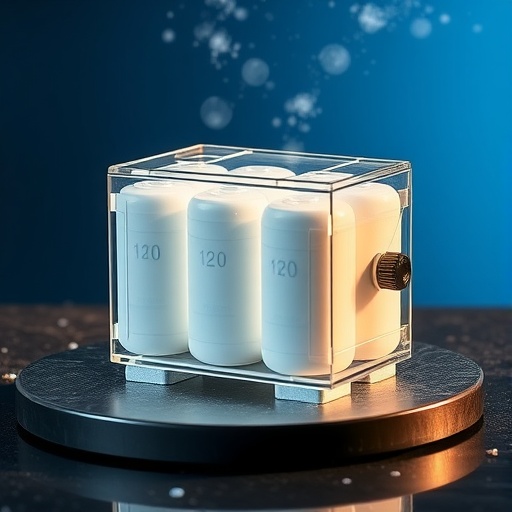As the electric vehicle market continues to expand and evolve, the need for sustainable battery recycling methods has never been more pressing. The surge in used lithium-ion batteries presents a challenge and an opportunity, as these batteries are rich in valuable metals including nickel, cobalt, and lithium. Traditional recycling methods often fracture the intricate crystal structures essential for the battery’s optimal performance. However, researchers from Huazhong University of Science and Technology have unveiled a groundbreaking molten salt technique that effectively restores the structural integrity and efficiency of high-nickel cathodes, heralding a more environmentally friendly and effective recycling methodology.
In their recent study, published in the journal Energy & Environment Nexus, the team introduces a direct regeneration strategy that leverages a unique molten salt mixture to rejuvenate degraded cathodes salvaged from end-of-life lithium-ion batteries. This innovative process represents a significant departure from conventional practices that typically dismantle materials into their metal constituents. Instead of merely extracting metals, this new technique is designed to revitalize the materials, allowing them to be repurposed in the production of new batteries.
The corresponding author of the study, Yang Yang, states, “Traditional recycling can recover metals, but it cannot bring back the original atomic structure of the material.” The breakthrough, however, has made it possible for degraded cathodes to regain their original crystal order and charge-holding capacity. This transformative approach could redefine standards in battery recycling, shifting the focus from raw material recovery to material restoration.
The research primarily focused on LiNi0.8Co0.1Mn0.1O2 (NCM811), a high-performance cathode material known for its superior energy density—crucial for electric vehicle applications. Over time, this material succumbs to lithium depletion and structural imperfections, leading to diminished charge capacity. To combat this degradation, the researchers crafted a ternary molten salt solution consisting of lithium hydroxide, lithium nitrate, and lithium salicylate. Upon heating, the molten salt becomes a fluid medium that facilitates the movement of lithium ions, enabling them to infiltrate the damaged cathode while promoting the reorganization of atoms into their pristine structure.
The effectiveness of this regeneration method was corroborated through detailed microscopic and spectroscopic analyses, which revealed that the regenerated NCM811 regained a uniform single-crystal structure. Remarkably, the undesirable surface “rock salt” layer was fully eradicated in the process. The regenerated cathode exhibited an initial discharge capacity of 196 milliamp hours per gram—an impressive figure that retained 76 percent of its capacity after 200 charge-discharge cycles, thereby outperforming prevailing recycling techniques.
Fangshu He, the study’s first author, elaborated on the significance of their findings, noting that “This process effectively heals the internal and surface damage of the cathode material. It not only replaces the lost lithium but also restores the ordered layered structure that is key to long battery life.” This dual-action approach of restoring lost lithium and repairing structural integrity is a game-changer in the quest for longer-lasting and more efficient batteries.
Moreover, one of the most compelling advantages of the molten salt system is its operation at relatively low temperatures, which mitigates energy consumption while avoiding the use of harsh acids or hazardous solvents often implicated in traditional recycling methods. This aspect of the process not only enhances its environmental sustainability but also aligns with the growing demand for green technologies.
The researchers are envisioning their method as a potential foundation for closed-loop recycling, which would enable direct conversion of used batteries back into high-quality materials for new units. This innovative methodology could serve as a pivotal step toward reducing the environmental footprint of battery production and establishing a more sustainable energy storage landscape.
While the current experiments have been conducted at the laboratory scale, there are plans in place to refine the process for broader industrial applications. A comprehensive life cycle assessment is also in the pipeline to thoroughly evaluate the environmental impacts of this cutting-edge recycling technique. Optimizing this process for commercial scalability could significantly alleviate the overall environmental burden associated with battery disposal while concurrently lowering recycling costs.
Ultimately, the implications of this research stretch far beyond the laboratory. As the global demand for electric vehicles continues to rise, so too does the urgency in developing effective recycling solutions that can meet the future’s energy storage requirements sustainably. The work undertaken by this team represents not only an advance in material science but also a commitment to the future of sustainable technology.
In conclusion, as we pivot toward a more electrified world, the developments in battery recycling presented by researchers from Huazhong University of Science and Technology provide a much-needed ray of hope. Their molten salt regeneration technique not only enhances the longevity and performance of battery materials but also fortifies the framework for sustainable practices in the rapidly growing electric vehicle market. The path forward will undoubtedly require collaborative efforts and ongoing innovations, but the groundwork laid by this research is a promising step in the right direction.
Subject of Research: Regeneration of lithium-ion battery cathodes
Article Title: Molten salt regeneration of single-crystal LiNi0.8Co0.1Mn0.1O2 from end-of-life cathodes
News Publication Date: 16-Oct-2025
Web References: Energy & Environment Nexus
References: He F, Lv Y, Wu J, Zhang Q, Hao S, et al. 2025. Molten salt regeneration of single-crystal LiNi0.8Co0.1Mn0.1O2 from end-of-life cathodes. Energy & Environment Nexus 1: e007
Image Credits: Fangshu He, Yuelin Lv, Jingyuan Wu, Qi Zhang, Shuaipeng Hao, Lixia Yuan, Haiping Yang & Yang Yang
Keywords
Nickel, Salts, Lithium ion batteries, Recycling




